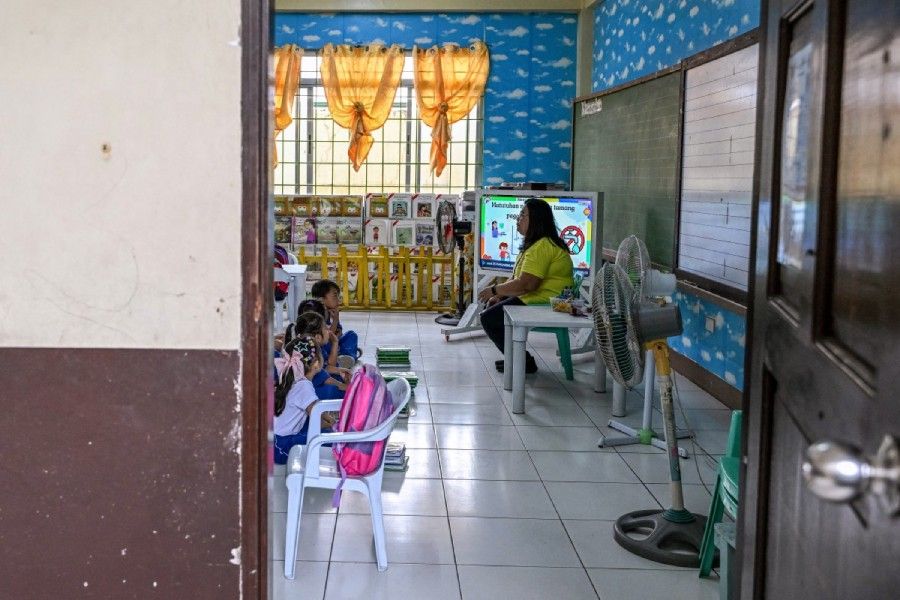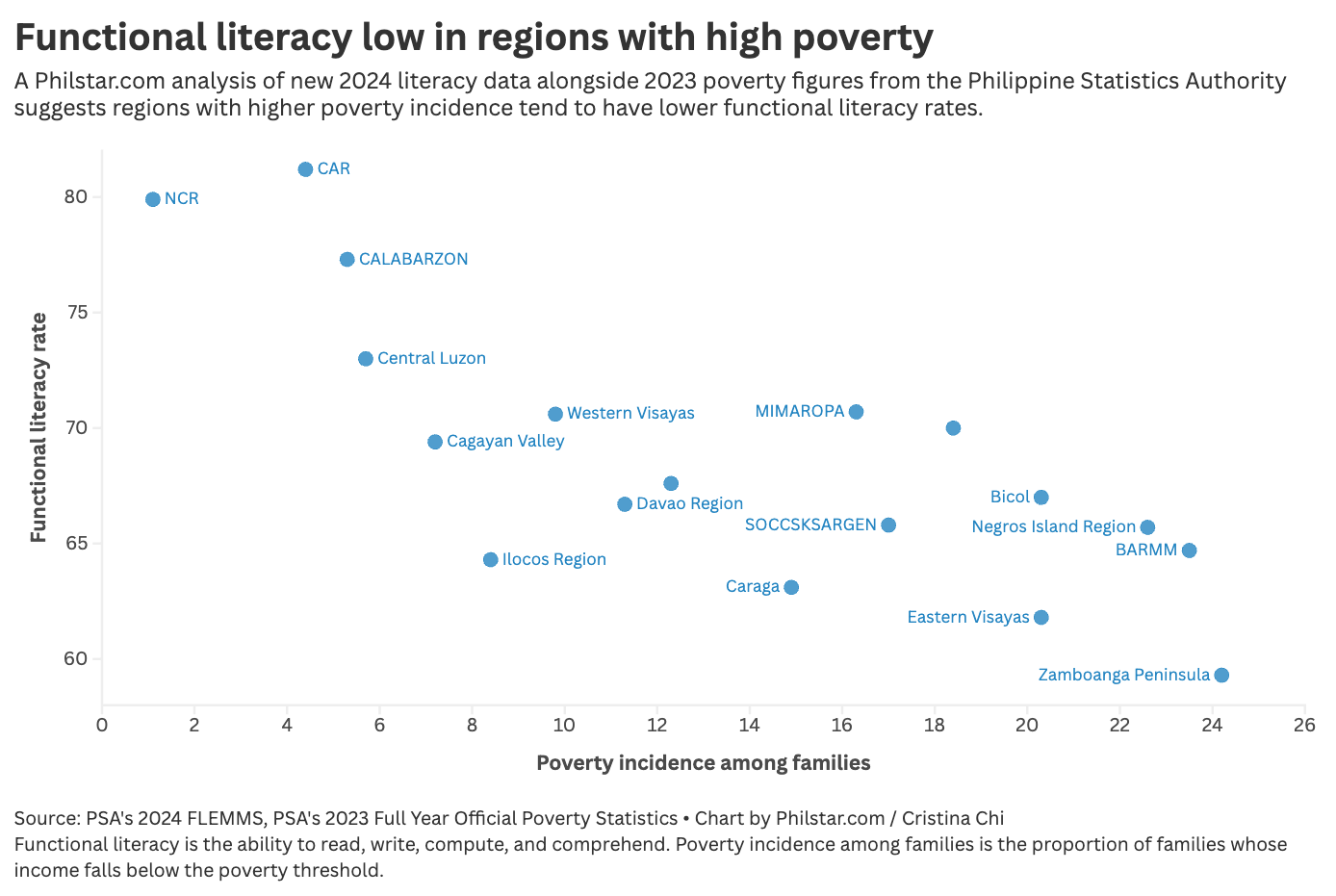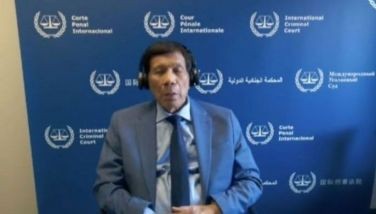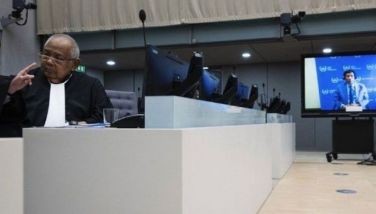3 in 10 Filipinos struggle to comprehend what they read — but poverty deepens the problem

MANILA, Philippines — While over 90% of Filipinos can read and write, just 70% can comprehend what they read — with the disparity reaching its most severe levels in regions hit hardest by poverty.
New data from the Philippine Statistics Authority's survey on the state of literacy in the country shows that regions with lower-than-average functional literacy rate tend to be the same regions where poverty incidence among families is higher than the national average.
Studies on social development in the Philippines generally draw a relationship between poverty and education: economic hardship often curtails access to quality education, while poor educational outcomes make it harder for families to break the cycle of poverty.
Drawing on the data from PSA's newly released 2024 Functional Literacy, Education, and Mass Media Survey (FLEMMS) and the 2023 poverty incidence among families, Philstar.com's analysis indicates that in places where the poverty incidence is higher than the national average of 10.9%, the functional literacy rate also tends to be lower than the national average of 70.8%.
A new understanding of literacy
The FLEMMS is a nationwide household survey conducted every five years by the PSA to gather data on the state of literacy in the country, among others.
For the first time since 1989, the FLEMMS has updated its definitions for basic and functional literacy.
Basic literacy measures a person's ability to "read and write a simple message in any language or dialect with understanding, and to compute or perform basic mathematical operations," the PSA said in its April 4 news release.
Functional literacy takes basic literacy a step higher by adding a crucial element: comprehension.
"In addition to the basic literacy skills, functional literacy includes higher level of comprehension skills, such as integrating two or more pieces of information and making inferences based on the given information," the PSA said.
Previous definitions did not include comprehension as a requirement for functional literacy.
This distinction means that the PSA survey revealed just how much of the country's population can read but may not understand what they are reading.
Data shows among Filipinos aged 10 to 64, at least 93.1 percent have basic literacy, but only 70.8 percent achieve functional literacy. The 22.3 percentage point gap represents millions who can recognize words but struggle to extract their meaning.
Where literacy and poverty intersect
Philstar.com cross-referenced PSA's latest literacy rates with its 2023 poverty statistics and found that, where poverty is most widespread, literacy is also taking a hit.
Specifically, 11 out of the country’s 18 regions with higher-than-average poverty incidence in 2023 (the latest available data from PSA) also recorded below-average functional literacy rates in the 2024 survey.

For example, in 2023, the Bangsamoro Autonomous Region in Muslim Mindanao (BARMM) had the highest poverty incidence among other regions at 23.5%. In 2024, its functional literacy rate for the population aged 10 to 64 years was 64.7%, which is below the national average of 70.8%.
Similarly, Region IX (Zamboanga Peninsula) had a poverty incidence of 24.2% in 2023, and a functional literacy rate of 59.3% in 2024, also below the national average.
Conversely, in the National Capital Region, where poverty rates are lowest, functional literacy approaches 80%.
Age and gender dimensions
The literacy gap varies not only by region but also by age and gender. Women outperform men in both basic literacy (90.9% vs. 89%) and functional literacy (74.1% vs. 67.6%), according to the PSA's survey.
Among age groups, Filipinos aged 20-24 show the highest functional literacy at 78.2%, while those aged 60-64 record the lowest at 57.8%.
The comprehension gap — the difference between basic and functional literacy — widens with age. For Filipinos aged 60-64, the gap reaches 33 percentage points, meaning that for every three older citizens who can read and write, one struggles with comprehension.
Literacy a 'critical concern'
The PSA's latest survey shows that more needs to be done to close the gap between basic and functional literacy across the country, said Karol Mark Yee, executive director of the Second Congressional Commission on Education (EDCOM 2).
EDCOM 2 is a congressional body tasked with conducting an independent review of the entire education system to come up with possible solutions to the country's education crisis.
"The recent FLEMMS data highlights the issue that 30% of our population might be lacking essential literacy skills. This aligns with our internal analysis and further confirms that literacy remains a critical concern that needs immediate action," Yee told Philstar.com.
While literacy is a problem among the current school population, Yee said, this also "extends to graduates already in the workforce, where the lack of fundamental literacy skills can limit their job opportunities, and hinder their personal and professional development."
Yee said EDCOM 2 will further examine the FLEMMS data. The results released last week however "already makes it clear that there is an immediate need to prioritize foundational literacy," he added.
"We must ensure that Filipino learners are equipped with functional literacy by Grade 3. Fixing the foundations of our education system, early childhood to Grade 3, is a task we must approach with utmost urgency," Yee added.
Education experts often point to Grade 3 as a critical benchmark for when students must be able to learn to read, because beyond this age (8 to 9 years old), children will primarily be expected to read to learn.
In 2022, the World Bank reported that learning poverty in the Philippines is at 91%, indicating that about nine out of ten children aged 10 have difficulty reading simple text.
- Latest
- Trending



























